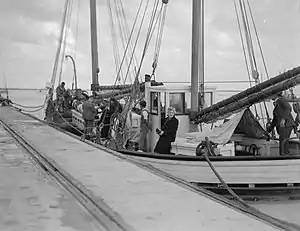Batavia Road (boat)
Batavia Road was a passenger boat used from 1946 for commercial tourist operation in the Houtman Abrolhos, a group of islands off the coast of Western Australia.
 Batavia Road taking on passengers, circa 1947 | |
| History | |
|---|---|
| Name | Batavia Road |
| Owner |
|
| Port of registry | Fremantle |
| Completed | 1946 |
| Identification | Official number 140199 |
| Fate | Wrecked 1974 |
| General characteristics | |
| Type | Auxiliary motor boat |
| Tonnage | 37grt |
| Length | 60.6 ft (18.5 m) |
| Beam | 18.5 ft (5.6 m) |
| Depth | 10.5 ft (3.2 m) |
| Sail plan | Ketch |
History
The 37grt ketch-rigged wooden motor boat Batavia Road was launched and completed in December 1946 by H Willmott & Co in Fremantle, Western Australia, from whom it had been ordered by the Australian Army during World War II.[1][2] The boat had a registered length of 60.6 ft (18.5 m), length overall of 66.0 ft (20.1 m), beam of 18.5 ft (5.6 m) and depth of 10.5 ft (3.2 m).[1][3] The boat was powered by a Gray marine diesel of 225 bhp, giving a speed of 8 knots.[3] It was registered at Fremantle in 1947 with official number 140199.[1]
In order to promote tourism to the Houtman Abrolhos, the Western Australia State Government obtained the boat from the Australian Army for purchase by Archdale "Dal" Gaze and Alan Fox.[1][2] Batavia Road made its first sailing from Geraldton on Christmas Day 1946 and until 1948, together with their another boat, Suda Bay, Gaze and Fox transported tourists to and from the Houtman Abrolhos, especially Pelsaert Island.[2][4] This was the first known commercial tourist operation in the Houtman Abrolhos. After the partnership split in 1948, Gaze continued using Batavia Road for tourism, as well as transporting stores and their catch for lobster fishermen based on the islands.[5] On 13 June 1948 a cyclone struck the Houtman Abrolhos and the Batavia Road was blown ashore at Wreck Point, near the Half Moon Reef and was nearly sunk. Tourists assisted the crew in salving the boat and fabricating a replacement rudder and, after help from fishermen, they were able to make the passage back to Geraldton.[6] Repairs were extensive and the boat returned to service in August 1948.[7]
Gaze eventually wound up his tourist operation in 1951.[5]
Later, Batavia Road passed to other owners, and foundered on rocks 20 miles (32 km) north of Geraldton on 25 January 1974.[1]
An anchorage at Pelsaert Island is named Batavia Road.[8]
References
- Dickson, Rod (1996). "Ships Registered in Western Australia from 1856 to 1969" (PDF). Guilderton, Western Australia: Maritime Heritage Association. pp. 185–186. Retrieved 28 December 2020.
- Stanbury, Myra. "Pelsaert Island: A Photographic Record" (PDF). Perth WA: Western Australian Museum. p. 54. Archived from the original (PDF) on 28 December 2020. Retrieved 28 December 2020.
- "For Sale: Auxiliary Schooner". Daily News. No. Vol.LXV, No.22, 678. Perth, Western Australia. 16 December 1947. p. 17. Retrieved 29 December 2020.
- "Abrolhos Islands Trips". Geraldton Guardian and Express. No. Vol.XVIII, No.3187. 17 December 1946. p. 2. Retrieved 28 December 2020.
- "Sustainable Tourism Plan for the Abrolhos Islands" (PDF). Fisheries Management Paper. Perth, Western Australia: Fisheries Western Australia. 2001. Archived from the original (PDF) on 24 March 2012. Retrieved 17 November 2007.
- "Abrolhos Islands Saga". Geraldton Guardian. No. Vol.XX, No.3416. 17 June 1948. p. 5. Retrieved 28 December 2020.
- "First Official Message". Geraldton Guardian. No. Vol.XX, No.3437. 5 August 1948. p. 2. Retrieved 28 December 2020.
- Sailing Directions: North, West and South Coasts of Australia (10th ed.). Bethesda MD, USA: National Geospatial-Intelligence Agency. 2010. p. 119. Retrieved 28 December 2020.
Further reading
- Uren, Norman (1949). Abrolhos Islands. Western Australian Education Department, Government Instructional Films (unpublished).